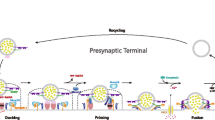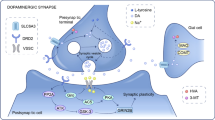Abstract
Attention deficit hyperactivity disorder (ADHD) is one of the most highly heritable behavioral disorders in childhood, with heritability estimates between 60 and 90 %. Family, twin and adoption studies have indicated a strong genetic component in the susceptibility to ADHD. The synaptosomal-associated protein of molecular weight 25 kDa (SNAP25) is a plasma membrane protein known to be involved in synaptic and neural plasticity. Animal model studies have shown that SNAP25 gene is responsible for hyperkinetic behavior in the coloboma mouse. In recent studies, several authors reported an association between SNAP25 and ADHD. In this study, we used a case–control approach to analyze the possible association of two polymorphisms of SNAP25 for possible association with ADHD in a sample of 73 cases and 152 controls in a Colombian children population. Polymorphisms are located in 3′ untranslated region of SNAP25, positions T1065G and T1069C. We found a significant association with the GT haplotype (rs3746554|rs1051312) of SNAP25 (p = 0.001). Evidence of association was also found for the G/G genotype of rs3746554 (p = 0.002) and C/C genotype of rs1051312 (p = 0.009). This is the first study in a Latin American population. Similar to other studies, we found evidence of the association of SNAP25 and ADHD.
Similar content being viewed by others
References
Bark I, Wilson M (1994) Regulated vesicular fusion in neurons: snapping together the details. Proc Natl Acad Sci USA 91:4621–4624
Barr CL, Feng Y, Wigg K et al (2000) Identification of DNA variants in the SNAP-25 gene and linkage study of these polymorphisms and attention-deficit hyperactivity disorder. Mol Psychiatry 5:405–409
Biederman J, Faraone SV (2005) Attention-deficit hyperactivity disorder. Lancet 366:237–248
Chang S, Zhang W, Gao L, Wang J (2012) Prioritization of candidate genes for attention deficit hyperactivity disorder by computational analysis of multiple data sources. Protein Cell 3:526–534
Coolidge F, Thede L, Young S (2000) Heritability and the comorbidity of attention deficit hyperactivity disorder with behavioral disorders and executive function deficits: a preliminary investigation. Dev Neuropsychol 17:273–287
Faraone SV, Sergeant J, Gillberg C, Biederman J (2003) The worldwide prevalence of ADHD: is it an American condition? World Psychiatry Off J World Psychiatr Assoc WPA 2:104–113
Faraone SV, Perlis RH, Doyle AE et al (2005) Molecular genetics of attention-deficit/hyperactivity disorder. Biol Psychiatry 57:1313–1323
Forero DA, Arboleda GH, Vasquez R, Arboleda H (2009) Candidate genes involved in neural plasticity and the risk for attention-deficit hyperactivity disorder: a meta-analysis of 8 common variants. J psychiatry Neurosci JPN 34:361–366
Gizer IR, Ficks C, Waldman ID (2009) Candidate gene studies of ADHD: a meta-analytic review. Hum Genet 126:51–90
Grünblatt E, Geissler J, Jacob CP et al (2012) Pilot study: potential transcription markers for adult attention-deficit hyperactivity disorder in whole blood. Atten Defic Hyperact Disord 4:77–84
Hawi Z, Matthews N, Wagner J et al (2013) DNA variation in the SNAP25 gene confers risk to ADHD and is associated with reduced expression in prefrontal cortex. PLoS ONE 8:e60274
Hess EJ, Collins KA, Wilson MC (1996) Mouse model of hyperkinesis implicates SNAP-25 in behavioral regulation. J Neurosci 16:3104–3111
Kovacs-Nagy R, Sarkozy P, Hu J et al (2011) Haplotyping of putative microRNA-binding sites in the SNAP-25 gene. Electrophoresis 32:2013–2020
Kustanovich V, Merriman B, McGough J et al (2003) Biased paternal transmission of SNAP-25 risk alleles in attention-deficit hyperactivity disorder. Mol Psychiatry 8:309–315
Pazvantoğlu O, Güneş S, Karabekiroğlu K et al (2013) The relationship between the presence of ADHD and certain candidate gene polymorphisms in a Turkish sample. Gene 528:320–327
Purcell S, Neale B, Todd-Brown K et al (2007) PLINK: a tool set for whole-genome association and population-based linkage analyses. Am J Hum Genet 81:559–575
Renner TJ, Walitza S, Dempfle A et al (2008) Allelic variants of SNAP25 in a family-based sample of ADHD. J Neural Transm 115:317–321
Sarkar K, Bhaduri N, Ghosh P et al (2012) Role of SNAP25 explored in eastern Indian attention deficit hyperactivity disorder probands. Neurochem Res 37:349–357
Solé X, Guinó E, Valls J et al (2006) SNPStats: a web tool for the analysis of association studies. Bioinformatics 22:1928–1929
Steffensen SC, Wilson MC, Henriksen SJ (1996) Coloboma contiguous gene deletion encompassing Snap alters hippocampal plasticity. Synapse 22:281–289
Südhof TC (1995) Synaptic core complex of synaptobrevin, syntaxin, and SNAP25 forms high affinity alpha-SNAP binding site. J Biol Chem 270:2213–2217
Svenaeus F (2013) Diagnosing mental disorders and saving the normal: American Psychiatric Association, 2013. Diagnostic and statistical manual of mental disorders, 5th edn. American Psychiatric Publishing, Washington, DC, Med Health Care Philos p 991
Vélez-van-Meerbeke A, Zamora IP, Guzmán G et al (2012) Evaluating executive function in schoolchildren with symptoms of attention deficit hyperactivity disorder. Neurologia 28:348–355
Zhang H, Zhu S, Zhu Y et al (2011) An association study between SNAP-25 gene and attention-deficit hyperactivity disorder. Eur J Paediatr Neurol 15:48–52
Conflict of interest
The authors declare that they have no conflict of interest.
Author information
Authors and Affiliations
Corresponding author
Rights and permissions
About this article
Cite this article
Gálvez, J.M., Forero, D.A., Fonseca, D.J. et al. Evidence of association between SNAP25 gene and attention deficit hyperactivity disorder in a Latin American sample. ADHD Atten Def Hyp Disord 6, 19–23 (2014). https://doi.org/10.1007/s12402-013-0123-9
Received:
Accepted:
Published:
Issue Date:
DOI: https://doi.org/10.1007/s12402-013-0123-9




